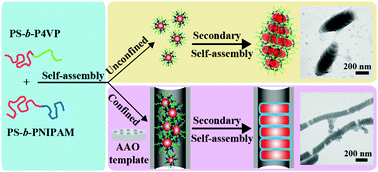Hierarchical self-assembly of a PS-b-P4VP/PS-b-PNIPAM mixture into multicompartment micelles and their response to two-dimensional confinement†
Abstract
Hierarchical self-assembly offers an elegant and energy-efficient bottom-up strategy for the fabrication of complex materials with precisely controllable morphologies and internal structures. Herein, pupa-like multicompartment micelles (MCMs) were readily fabricated via the hierarchical self-assembly of a polystyrene-block-poly(4-vinylpyridine) (PS-b-P4VP) and polystyrene-block-poly(N-isopropylacrylamide) (PS-b-PNIPAM) block copolymer mixture in a THF/water mixture solvent, which were unable to be obtained by any of the individual block copolymers (BCPs). This means that the hierarchical self-assembly is a result of the synergistic cooperation between the two BCPs. Moreover, a kinetic study revealed that the MCMs were formed by hierarchical self-assembly of small spherical micelles (SSMs), which were co-assembled from the PS-b-P4VP/PS-b-PNIPAM mixture. Subsequently, we investigated the self-assembly of a PS-b-P4VP/PS-b-PNIPAM mixed solution confined in the nanopores of an anodic aluminum oxide (AAO) template. In such two-dimensional confinement, long multicompartment micelles (LMCMs) with a period multilayer structure were obtained. Notably, the confinement effect of nanopores on the hierarchical self-assembly could be distinguished into two different situations according to the activity of secondary assembly of the preformed SSMs from different BCP compositions, i.e., dynamic and static confinement. The dynamic confinement can affect the Brownian movement of SSMs and thus promotes their fusion to form spherical micelles with larger size compared with the SSMs formed under an unconfined condition. For the situation where AAO nanopores were partially filled with the preformed SSMs, the static confinement could decrease the stretching of BCP chains along the short axis of LMCMs and thus induce the formation of long range ordered multilayer nanostructures. These results illustrated that the synergistic effect played an important role in the hierarchical assembly of BCPs; meanwhile, such hierarchical self-assembly could be further manipulated by cylindrical confinement to rationally tune the nanostructures and dimensions of the BCP assemblies.



 Please wait while we load your content...
Please wait while we load your content...